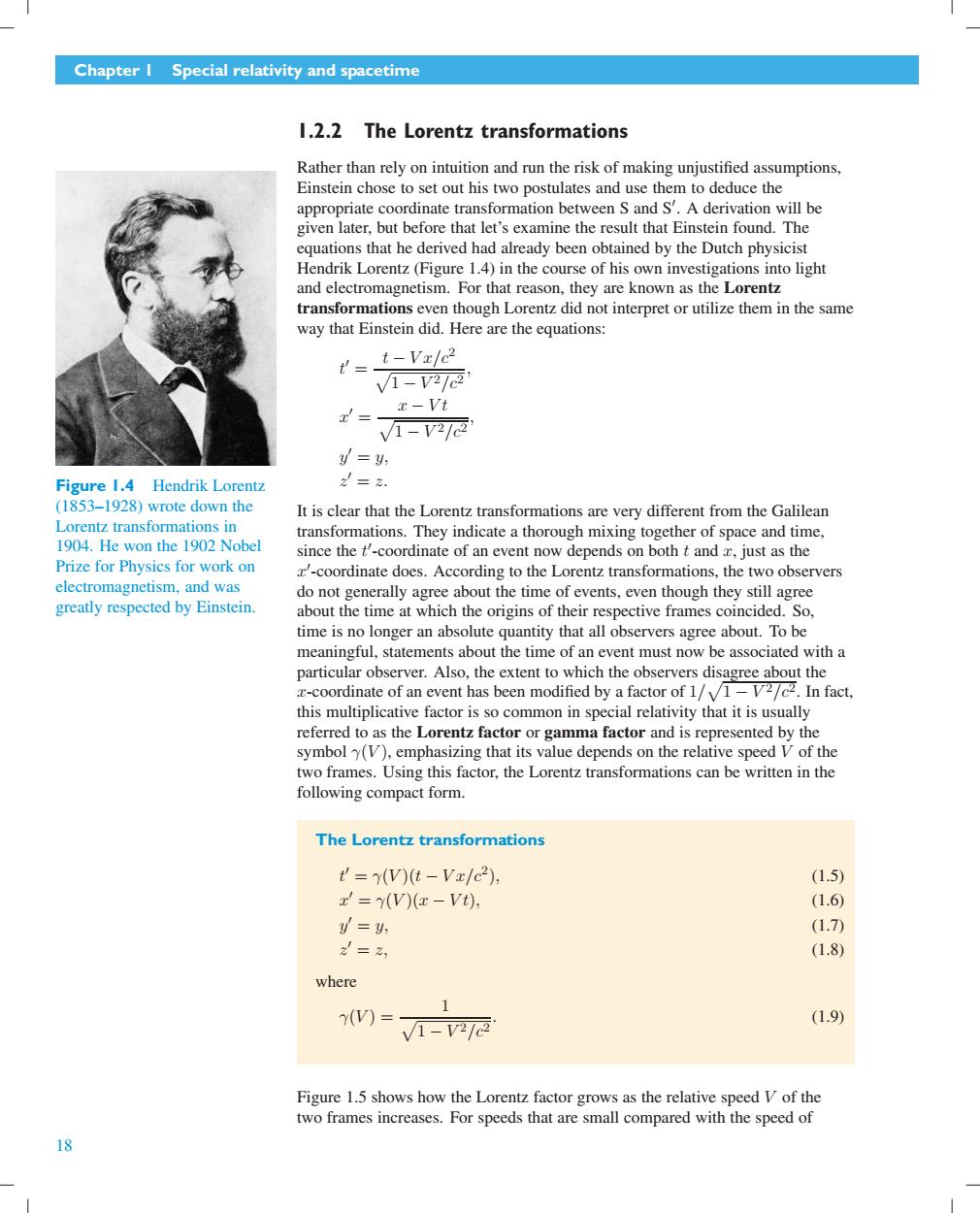正在加载图片...

Chapter I Special relativity and spacetime 1.2.2 The Lorentz transformations Rather than rely on intuition and run the risk of making unjustified assumptions, Einstein chose to set out his two postulates and use them to deduce the appropriate coordinate transformation between S and S'.A derivation will be given later,but before that let's examine the result that Einstein found.The equations that he derived had already been obtained by the Dutch physicist Hendrik Lorentz(Figure 1.4)in the course of his own investigations into light and electromagnetism.For that reason,they are known as the Lorentz transformations even though Lorentz did not interpret or utilize them in the same way that Einstein did.Here are the equations: t=_ t-Vzlc2 vV1-V2/c21 t= x-Vt V1-2/21 =y, Figure 1.4 Hendrik Lorentz 之=. (1853-1928)wrote down the It is clear that the Lorentz transformations are very different from the Galilean Lorentz transformations in transformations.They indicate a thorough mixing together of space and time, 1904.He won the 1902 Nobel since the t'-coordinate of an event now depends on both t and x,just as the Prize for Physics for work on x'-coordinate does.According to the Lorentz transformations,the two observers electromagnetism,and was do not generally agree about the time of events,even though they still agree greatly respected by Einstein. about the time at which the origins of their respective frames coincided.So, time is no longer an absolute quantity that all observers agree about.To be meaningful,statements about the time of an event must now be associated with a particular observer.Also,the extent to which the observers disagree about the x-coordinate of an event has been modified by a factor of 1/1-V2/c2.In fact, this multiplicative factor is so common in special relativity that it is usually referred to as the Lorentz factor or gamma factor and is represented by the symbol (V),emphasizing that its value depends on the relative speed V of the two frames.Using this factor,the Lorentz transformations can be written in the following compact form. The Lorentz transformations t=7(V)(t-Vz/c2), (1.5) I'=y(v)(x-Vt), (1.6 y=y, (1.7) 之=, (1.8) where 1 y(V)= (1.9) /1-2/c2 Figure 1.5 shows how the Lorentz factor grows as the relative speed V of the two frames increases.For speeds that are small compared with the speed of 18Chapter 1 Special relativity and spacetime 1.2.2 The Lorentz transformations Rather than rely on intuition and run the risk of making unjustified assumptions, Einstein chose to set out his two postulates and use them to deduce the appropriate coordinate transformation between S and S % . A derivation will be given later, but before that let’s examine the result that Einstein found. The equations that he derived had already been obtained by the Dutch physicist Hendrik Lorentz (Figure 1.4) in the course of his own investigations into light and electromagnetism. For that reason, they are known as the Lorentz transformations even though Lorentz did not interpret or utilize them in the same way that Einstein did. Here are the equations: Figure 1.4 Hendrik Lorentz (1853–1928) wrote down the Lorentz transformations in 1904. He won the 1902 Nobel Prize for Physics for work on electromagnetism, and was greatly respected by Einstein. t % = t − V x/c2 - 1 − V 2/c2 , x % = x − V t - 1 − V 2/c2 , y % = y, z % = z. It is clear that the Lorentz transformations are very different from the Galilean transformations. They indicate a thorough mixing together of space and time, since the t % -coordinate of an event now depends on both t and x, just as the x % -coordinate does. According to the Lorentz transformations, the two observers do not generally agree about the time of events, even though they still agree about the time at which the origins of their respective frames coincided. So, time is no longer an absolute quantity that all observers agree about. To be meaningful, statements about the time of an event must now be associated with a particular observer. Also, the extent to which the observers disagree about the x-coordinate of an event has been modified by a factor of 1/ - 1 − V 2/c2 . In fact, this multiplicative factor is so common in special relativity that it is usually referred to as the Lorentz factor or gamma factor and is represented by the symbol γ(V ), emphasizing that its value depends on the relative speed V of the two frames. Using this factor, the Lorentz transformations can be written in the following compact form. The Lorentz transformations t % = γ(V )(t − V x/c2 ), (1.5) x % = γ(V )(x − V t), (1.6) y % = y, (1.7) z % = z, (1.8) where γ(V ) = 1 - 1 − V 2/c2 . (1.9) Figure 1.5 shows how the Lorentz factor grows as the relative speed V of the two frames increases. For speeds that are small compared with the speed of 18